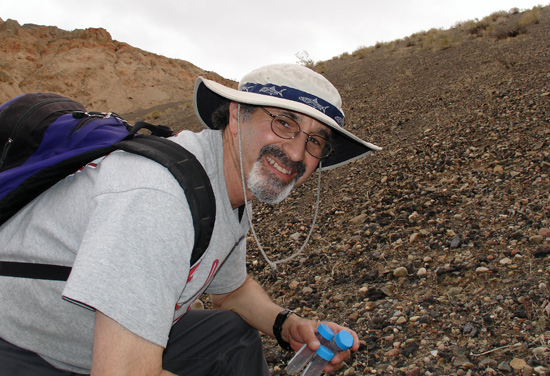Professor Develops Ecology-Based Classification System for Microbes
 |
| Fred Cohan, professor of biology, searches for microbe samples in Death Valley, Calif. |
| Posted 06/03/08 |
| While exploring Death Valleys parched landscape, Professor of Biology Fred Cohan collected samples of compacted clay from the dry grounds. He sought a bacterium that is closely related to the microbe Bacillus subtilis, previously isolated from neighboring, gravel-based terrains.
B. subtilis has similar genes and DNA as the bacteria Cohan discovered living in the clay soils, but Cohan argues that the clay-thriving microbe represents an ecologically-distinct ecotype of bacteria that has adapted to the low-nutrient habitat. We have identified and confirmed that Bacillus living in the clay soils is ecologically distinct from the bacteria living in the gravel soils, Cohan explains. Vegetation does not grow on the clay, so this makes us question how this newly discovered Bacillus has the ability to live with fewer food resources. Alternatively, this clay ecotype may have special adaptations for living in the unique chemical and physical conditions of the clay. Cohan, who has researched evolutionary genetics and biogeography of bacteria at Wesleyan for 22 years, will soon propose to scientifically classify the clay-thriving microbe as Bacillus subtilis, with an attached ecospecies name borrowing a Native American word for badlands. Cohan also discovered that bacteria living in hotter, south-facing desert slopes are ecologically distinct from the closely related bacteria living in cooler, north-facing slopes, although the soil is similar. We found that Bacillus ecotypes living on the south-facing slopes have greater growth rates at stressful high temperatures, and they produce greater amounts of particular kinds of fatty acids that are beneficial for heat tolerance in their cell membranes. Cohan says. These north- and south-facing populations are so closely related that they would likely escape the attention of bacterial systematists, yet we have shown that they are significantly different members of this bacterial community. He bases microbe classifications on similarity in lifestyle and habitat, whereas the scientific classifications norm is based on gene and metabolic similarities, without direct regard for ecology. Current methods in bacterial systematics fail to divide the bacterial domain into meaningful units of ecology and evolution, Cohan says. We are looking beyond the species and identifying groups of bacteria within a species by their ecotypes to understand what ecologically distinguishes the closest of relatives. In attempt to categorize other microbes by ecotypes, Cohan co-developed a software package called ecotype simulation, with aid from colleagues and students in the Department of Biology and Department of Mathematics and Computer Science. The program, which is accessible online for public use, models the evolutionary dynamics of bacteria and identifies ecotypes within a natural community. Cohan and fellow researchers already used the computing method to identify 30 distinct Bacillus ecotypes in Israel desert-scapes. They presented their findings, and noted the ecotype simulation method in a paper titled Identifying the fundamental units of bacterial diversity: A paradigm shift to incorporate ecology into bacterial systematics, which was published by the Proceedings of the National Academy of Sciences on Feb. 12. Cohan’s views on identifying bacterial ecotypes were featured in the May 23 issue of Science Magazine and the June 2008 issue of Scientific American. Other Wesleyan faculty and students who contributed to the research and Ecotype Simulation software are Danny Krizanc, professor of computer science; undergraduates Andrew Burger 09, Scott Cole 09, Andrew Warner 08, and Jane Wiedenbeck 10; biology masters students Nora Connor BA 07 and Elizabeth Perry BA 06 MA 07; Ph.D candidate Alex Koeppel; and Regensburg University exchange student Konstanze Schiessl. We introduced a sequence-based approach, which has already identified multiple ecotypes within traditional species, says Krizanc says. Ecotype simulation provides a long-needed natural foundation for microbial ecology and systematics. Classifying bacteria at the level of ecotypes will bring important advantages to all kinds of microbiologists, Cohan explains. An ecotype-based classification will allow microbiologists to work more efficiently by focusing on strains most likely to differ in physiology and genome content by choosing organisms from different ecotypes. In preparation for future epidemics, epidemiologists could identify all of the long-standing ecotype diversity within each named pathogenic species; they could then anticipate and prepare for future epidemics by characterizing the disease-causing properties of each ecotype. Biotechnologists may also take advantage of an ecotype-based systematics. After discovering a strain with a valuable enzyme, biotechnologists could discover similar enzymes with somewhat different properties by searching for the same enzyme in closely related ecotypes, Cohan says. An ecotype-based systematics will allow microbial ecologists to quantify the ecological diversity within a community. Finally, a classification of ecotypes will allow scientists to identify and characterize the ecologically-unique populations of bacteria, a critical step forward in understanding the ecological interactions within natural microbial communities. Now that Cohan has proposed a systematic way for identifying ecotypes, he recommends that all ecotypes be recognized and classified with a scientific name. We believe that the fullness of ecological diversity within the bacterial world will be taken most seriously when each ecotype is given its own name, he says. |
| By Olivia Drake, The Wesleyan Connection editor. Photo by Willie Cohan. |

